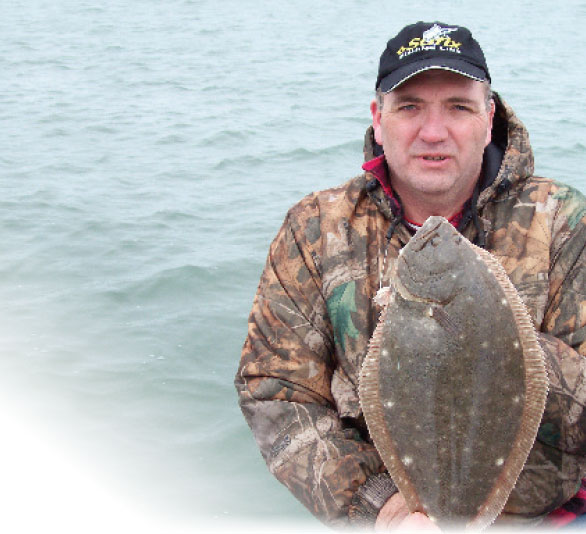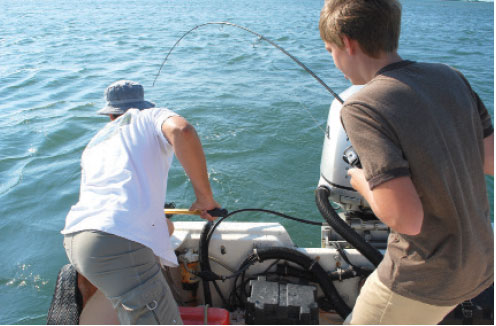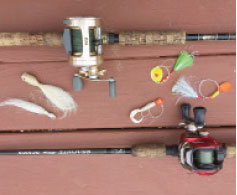
positioning needed
to make consistent catches of early
season summer
flounder.
As the fluke saga continues to unfold, anglers hitting southern backwaters this month get an early reward.
Early spring, and fluke are on the move. After wintering on the offshore grounds, they’re headed inshore. As they arrive along the coast in March and early April, many fluke move out of the cold ocean water and into tidal creeks, channels and canals where shallow water is warmed by the sun.
While off-limits in New Jersey until the middle of May, many local anglers itching for an early score have interesting opportunities available to them that would provide an exciting jump-start to their fluke fishing action.
It’s no secret to folks in the Philly/Wilmington area especially – anglers who might spend most days from Memorial Day and Labor Day at the Jersey Shore who kick off each new fishing season with spring trips to the Lewes-Rehoboth Canal in Lewes, DE, or about 90 miles farther south to the creeks and channels at Wachapreague on Virginia’s Eastern Shore.
While summer flounder are no doubt already there for the taking in South Jersey bays and tidal creeks, the application of this “creek and canal attack” will have to wait just a little bit longer until the regs allow it; but tactically speaking, on opening day here are a few ideas for you to help settle the score!
Skinny Water Flukin’
Weather, especially wind, is often the biggest challenge. Ideal springtime conditions in creeks, channels and canals, include a clear sky with lots of sunshine, little wind or a light breeze blowing with the current, clear water, and an outgoing tide, especially during the afternoon hours. The mid-day high tide will have been warmed by the sun, and will have drawn baitfish far up into very skinny water. Summer flounder will take up ambush positions in nearby deeper water in the middle of the creek or channel and will be ready for action as the outgoing current pulls baitfish out of the skinny water and toward hungry fluke.
However, premier conditions on the days we are available to fish are a long shot, to say the least, especially in April and May. As we are all keenly aware, spring weather can be fickle. Sunny, warm, comfortable conditions and clear water can quickly deteriorate into gloomy skies, rain, even snow showers accompanied by bone-chilling winds that dirty the water. Yet there are techniques that can be used to overcome uncooperative conditions.
First as a child with my uncle at numerous locations in New Jersey, then during my 10-year tenure in the 1990s as Managing Editor of The Fisherman’s Mid-Atlantic Edition in Lewes, DE, I had the good fortune to fish with, and learn from, savvy fluke fishermen. Now, decades later, I still use the valuable expertise they shared with me concerning bait, rigs, tackle and most importantly, boat positioning and control.
Fluke will be right in the middle of the creek or channel, so the goal is to drift over the middle of the creek or channel for as long as possible, as often as possible. Sounds simple, yet it’s shocking how many anglers allow the wind to push their boats sideways across the canal and out of the strike zone. It takes diligence, effort and determination to maintain pinpoint boat positioning, especially on breezy spring days. Failure to battle the elements will significantly diminish the productivity and enjoyment of the fluke trip.

Better Boat Control
Power drifting and trolling are effective methods of maintaining boat control. Someone who is willing to sacrifice some of their fishing time to operate the boat will need to be the designated driver, and he or she should expect to be busy. They need to steer clear of locations where the wind is blowing across the creek or channel; instead, they should seek out stretches of water where the breeze will push the boat in nearly the same general direction as the current. (Locations with the most favorable conditions will change throughout the day as the current and/or wind direction change.) Move to the middle of the creek or channel, drop baits to the bottom, put the motor in neutral (expect to keep it running all day long) and begin drifting.
As soon as the boat begins to drift out of the middle of the channel, put the running motor in reverse and ease the boat back into position. The boat is moved in reverse instead of forward because it’s easier to control the boat with the wind pushing against the wide, flat stern. Attempting to re-position the boat in forward usually results in the wind pushing against one side of the bow, causing the boat to spin or turn.
It’s often possible to leave lines in the water as the boat is moved. If not, pick them up, get back in the middle of the creek or channel, drop down and begin drifting again with the motor in neutral. Depending on your location and the length of your drifts, it may be necessary to run this zig-zag power drifting pattern to re-position the boat 50 or 60 times during a single drift. This may sound excessive, but maintaining proper boat positioning will pay off with consistently better fluke catches.
Put in the effort, and do not allow your time to be wasted fishing in water that is void of fluke!
Power Drift & Trolling
Trolling forward with rods in stern rodholders provides even greater boat control and positioning. When power drifting or trolling, use a sinker heavy enough to keep the rig in nearly constant contact with the bottom, as straight down from the boat as possible. Typically, 4- to 8-ounce sinkers work well when power drifting in 5- to 12-foot depths in creeks and channels, while 8- to 16-ounce sinkers may be needed while trolling. Using a sinker that’s too light and playing out line to maintain contact with the bottom often causes a rig to spin and lose its effectiveness.
Most of the expert fluke trollers and power drifters I have fished with put their rods in rodholders instead of holding them. This keeps hands free for boat maneuvering, bait preparation and other activities.
For power drifting, a two-hook top-bottom or high-low rig made from 40-pound fluorocarbon is recommended. At the bottom of a power drifting rig usually there’s an 18-inch leader with a fluke killer baited with a squid strip or minnow. A small bucktail is slipped directly onto the shorter loop or leader at the top of the rig. Use white bucktails, skirts and blades in clear water, and yellow or chartreuse in cloudy or dirty water. Popular baits to hang on the bucktail are one or two frozen silversides or smelt, which are hooked through the eyes, or a long squid strip.
A popular rig for fluke trollers features a three-way swivel tied to the end of the braided line from the reel, with a heavy sinker attached via the snap. A 24- to 30-inch fluorocarbon leader is tied to the third eye of the swivel. The hook at the end gets a plastic squid body or hair skirt. Use long, narrow strip baits, or Gulp! baits when trolling to maximize flutter and reduce spinning.
Later in the spring, as the weather and water continue to warm, anglers should be ready to follow fluke as they begin to move toward cooler water in inlets and creek mouths.
| LEGAL-EASE DE & TIDEWATER VA |
|---|
 For information on license requirements, public boat ramps, and bait and tackle shops, contact the Delaware Division of Fish and Wildlife at 302-739-9918. (www.eregulations.com/delaware/fishing/), and Virginia Fisheries Management at 757-491-5160 (www.mrc.virginia.gov/vswft/index.shtm). |



